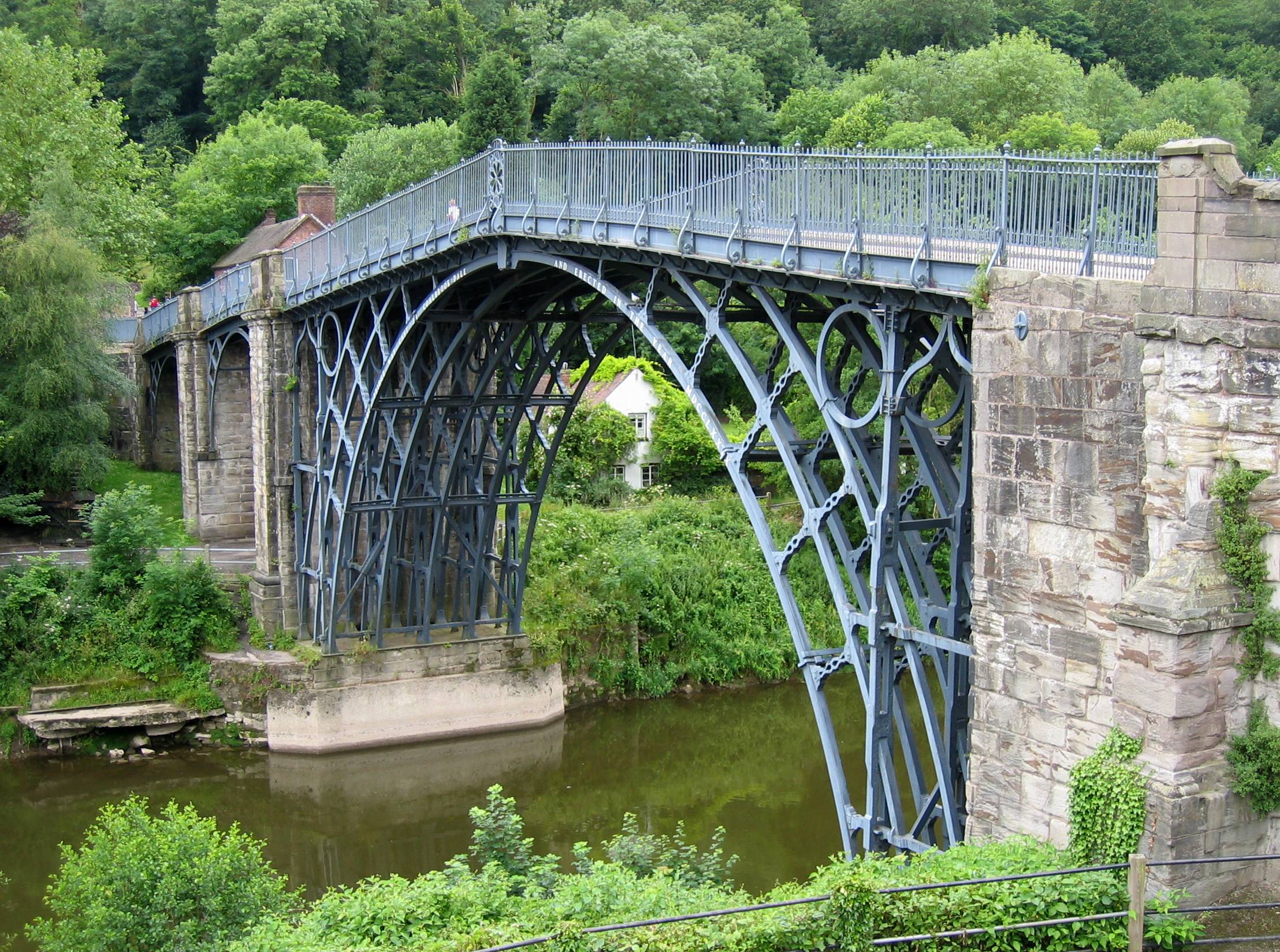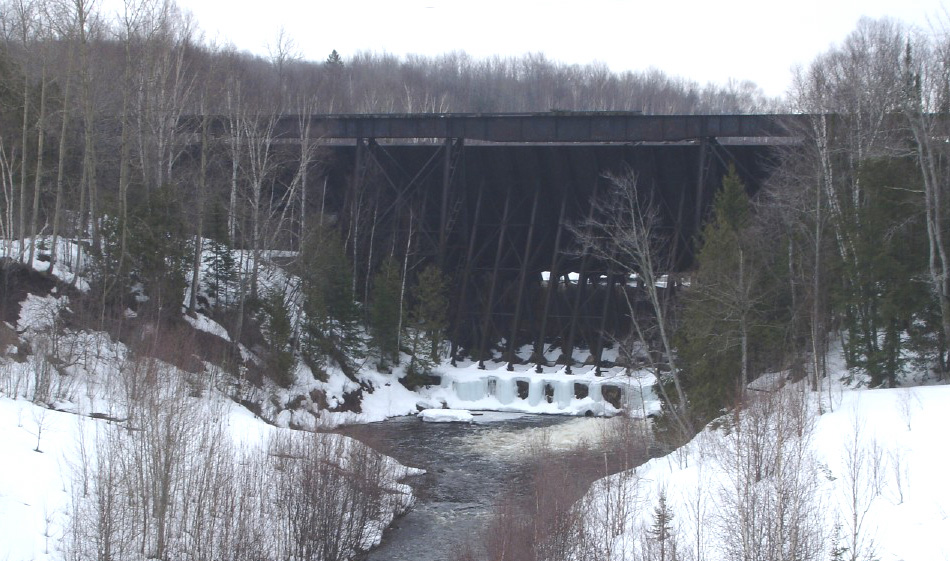|
Redridge Steel Dam
The Redridge Steel Dam is a steel dam across the Salmon Trout River in Redridge, Houghton County, Michigan. Completed in 1901, it is a flat slab buttress dam constructed of steel, a relatively rare material for construction of dams, which are typically made of earthenworks, concrete, or masonry. Most sources indicate that it was one of only three such dams constructed in the United States, the other two being the Ashfork-Bainbridge Steel Dam (1898, Arizona) and the Hauser Lake Dam (1907, Montana), the last of which failed within a year of construction. History In 1894, prior to the construction of the steel dam, the Atlantic Mining Company built a timber crib dam across the Salmon Trout River. The dam created a reservoir which supplied water to the Atlantic stamp mill which extracted copper from ore-bearing rock. With the growth of the Atlantic stamp mill and the construction of the Baltic Mining Company mill nearby, this reservoir proved to be insufficient, and in 1901 t ... [...More Info...] [...Related Items...] OR: [Wikipedia] [Google] [Baidu] |
Stanton Township, Michigan
Stanton Township is a civil township of Houghton County, Michigan, Houghton County in the Upper Peninsula of Michigan, Upper Peninsula of the U.S. state of Michigan. The population was 1,590 at the 2020 United States census, 2020 census. Stanton Township has the distinction of having the highest concentration of people with Finns, Finnish ancestry of any place in the United States, at 47%.U.S. census data as compiled beopdunk.com/ref> Geography According to the United States Census Bureau, the township has a total area of , of which is land and (1.00%) is water. Communities * Beacon Hill is an Unincorporated area#United States, unincorporated community in the township. It was a center of the Trimountain Mining Company, largely backed by Boston financiers, and the settlement was named after Beacon Hill, Boston, Beacon Hill neighborhood in that city. It was a station on the Copper Range Railroad. A post office operated from December 11, 1901, until August 31, 1952. * Craig Roy wa ... [...More Info...] [...Related Items...] OR: [Wikipedia] [Google] [Baidu] |
Industrial Archaeology
Industrial archaeology (IA) is the systematic study of material evidence associated with the Industry (manufacturing), industrial past. This evidence, collectively referred to as industrial heritage, includes buildings, machinery, artifacts, sites, infrastructure, documents and other items associated with the production, manufacture, extraction, transport or construction of a product or range of products. The field of industrial archaeology incorporates a range of disciplines including archaeology, architecture, construction, engineering, historic preservation, museology, technology, urban planning and other specialties, in order to piece together the history of past industrial activities. The scientific interpretation of material evidence is often necessary, as the written record of many industrial techniques is often incomplete or nonexistent. Industrial archaeology includes both the examination of standing structures and sites that must be studied by an Excavation (archaeology ... [...More Info...] [...Related Items...] OR: [Wikipedia] [Google] [Baidu] |
IA, The Journal Of The Society For Industrial Archeology
''IA: The Journal of the Society for Industrial Archeology'' is a biannual peer-reviewed academic journal published by the Society for Industrial Archeology, currently edited by Steven Walton (Michigan Technological University). ''IA'' publishes scholarly research, essays, and reviews of books published in the field of industrial archeology. History The first issue of ''IA'' was published in 1975, followed by one issue per year through volume 11 in 1985. The current biannual publication frequency began with volume 12 in 1986, although there have been several double issues. ''IA'' has published a number of issues with articles on a common theme, including Montréal's Lachine Canal (2003), the Springfield Armory (1988), the West Point Foundry (2009), and three on the Historic American Engineering Record Heritage Documentation Programs (HDP) is a division of the U.S. National Park Service (NPS). It administers three programs established to document historic places in the United ... [...More Info...] [...Related Items...] OR: [Wikipedia] [Google] [Baidu] |
Steel Dam
A steel dam is a type of dam (a structure to impound or retard the flow of water) that is made of steel, rather than the more common masonry, earthworks, concrete or timber construction materials. Relatively few examples were ever built. Of the three built in the US, two remain: the Ashfork-Bainbridge Steel Dam, built in 1898 in the Arizona desert to supply locomotive water to the Atchison, Topeka and Santa Fe Railway (ATSF), and the Redridge Steel Dam, built 1901, in the Upper Peninsula of Michigan to supply water to stamp mills. The third, the Hauser Lake Dam in Montana, was finished in 1907 but failed in 1908. Steel dams were found to be uneconomical after World War I, as the price of steel increased by many multiples, compared with cement prices. Their economics are highly favourable in 21st century due to lower total onsite labour costs, lower cost for bulk material transportation, availability of more construction time in a year, and flexibility in construction plan comply ... [...More Info...] [...Related Items...] OR: [Wikipedia] [Google] [Baidu] |
Michigan Technological University
Michigan Technological University (Michigan Tech, MTU, or simply Tech) is a public research university in Houghton, Michigan, United States. It was founded in 1885 as the Michigan Mining School, the first post-secondary institution in the Upper Peninsula of Michigan. The university comprises five colleges and schools: the College of Engineering, the College of Computing, the College of Sciences and Arts, the College of Business, and the College of Forest Resources and Environmental Science. They offer more than 140 degree programs to nearly 7,000 graduate and undergraduate students. Its main campus sits on on a bluff overlooking Portage Lake. The campus consists of 36 buildings, the first of which was built in 1908. Michigan Tech's athletic teams are nicknamed the Huskies and compete primarily in the NCAA Division II Great Lakes Intercollegiate Athletic Conference (GLIAC). The men's hockey team competes in Division I as a member of the Central Collegiate Hockey Associ ... [...More Info...] [...Related Items...] OR: [Wikipedia] [Google] [Baidu] |
Copper Range Company
The Copper Range Company was a major copper-mining company in the Copper Country of Michigan, United States. It began as the Copper Range Company in the late 19th century as a holding company specializing in shares in the copper mines south of Houghton, Michigan. The company was bought by Louisiana Land and Exploration in 1977. Amygdaloid native copper mining Copper Range controlled through share ownership the Copper Range Railroad and the Baltic Mining Company. The Copper Range Railroad served much of the southern part of the Copper Country, and the Baltic Mining Company owned the copper mine at Baltic, Michigan. In 1901, the Copper Range Company, prevented by Michigan law from issuing more shares of stock, incorporated a new entity in New Jersey, the Copper Range Consolidated Company. Copper Range Consolidated used its new shares to get control of more copper mining companies by stock swaps. It gained half the stock in the Champion mine. The company swapped shares to acquire ... [...More Info...] [...Related Items...] OR: [Wikipedia] [Google] [Baidu] |
Spillway
A spillway is a structure used to provide the controlled release of water downstream from a dam or levee, typically into the riverbed of the dammed river itself. In the United Kingdom, they may be known as overflow channels. Spillways ensure that water does not damage parts of the structure not designed to convey water. Spillways can include floodgates and fuse plugs to regulate water flow and reservoir level. Such features enable a spillway to regulate downstream flow—by releasing water in a controlled manner before the reservoir is full, operators can prevent an unacceptably large release later. Other uses of the term "spillway" include bypasses of dams and outlets of channels used during high water, and outlet channels carved through natural dams such as moraines. Water normally flows over a spillway only during flood periods, when the reservoir has reached its capacity and water continues entering faster than it can be released. In contrast, an intake tower is a structure ... [...More Info...] [...Related Items...] OR: [Wikipedia] [Google] [Baidu] |





